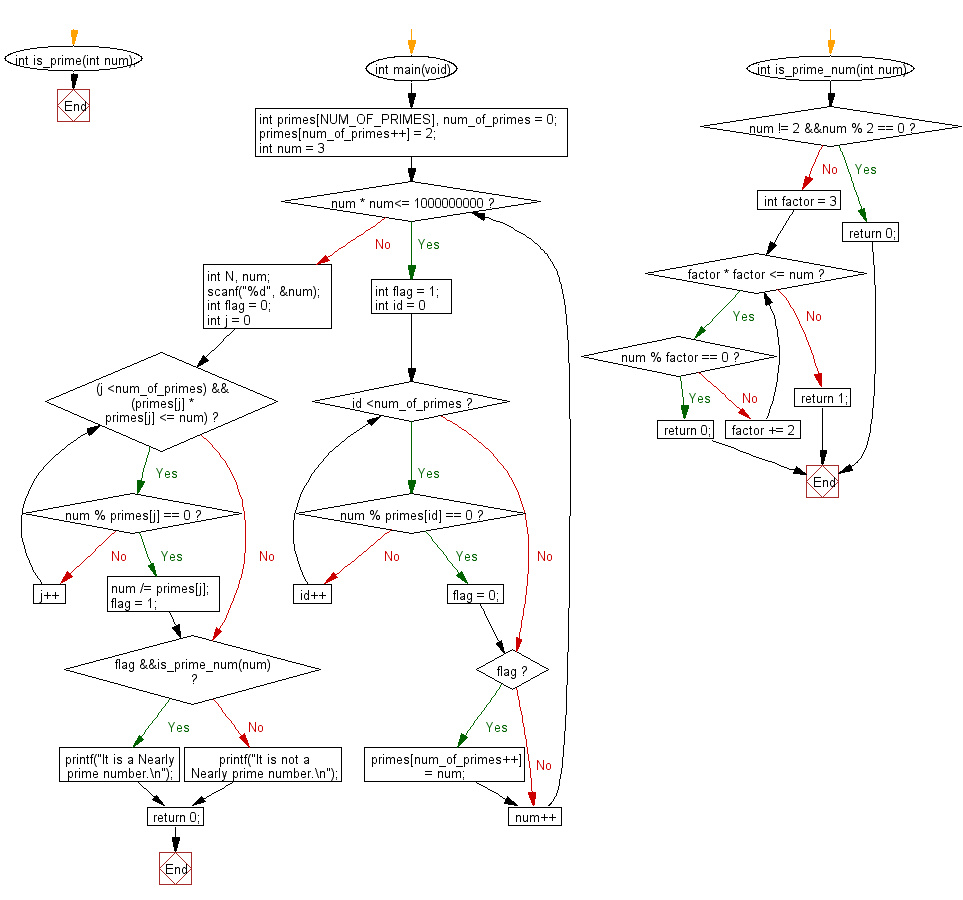C Exercises: Check if a given number is nearly prime or not
C Basic Declarations and Expressions: Exercise-93 with Solution
Write a C program to check if a given number is nearly prime or not.
Nearly prime number is a positive integer which is equal to product of two prime numbers.
Sample Solution:
C Code:
#include <stdio.h>
#define NUM_OF_PRIMES 3500
int is_prime(int num);
int main(void)
{
int primes[NUM_OF_PRIMES], num_of_primes = 0;
primes[num_of_primes++] = 2;
for(int num = 3; num * num<= 1000000000; num++)
{
int flag = 1;
for(int id = 0; id <num_of_primes; id++)
{
if(num % primes[id] == 0)
{
flag = 0;
break;
}
}
if(flag) primes[num_of_primes++] = num;
}
int N, num;
scanf("%d", &num);
int flag = 0;
for(int j = 0; (j <num_of_primes) && (primes[j] * primes[j] <= num); j++)
{
if(num % primes[j] == 0)
{
num /= primes[j];
flag = 1;
break;
}
}
if(flag &&is_prime_num(num)) printf("It is a Nearly prime number.\n");
else printf("It is not a Nearly prime number.\n");
return 0;
}
int is_prime_num(int num)
{
if(num != 2 &&num % 2 == 0) return 0;
for(int factor = 3; factor * factor <= num ; factor += 2)
{
if(num % factor == 0) return 0;
}
return 1;
}
Sample Output:
It is not a Nearly prime number.
Flowchart:

C programming Code Editor:
Contribute your code and comments through Disqus.
Previous:Write a C program to find the last non-zero digit of the factorial of a given positive integer.
Next: Write a C program to calculate body mass index and display the grade.
What is the difficulty level of this exercise?
Test your Programming skills with w3resource's quiz.
C Programming: Tips of the Day
Static variable inside of a function in C
The scope of variable is where the variable name can be seen. Here, x is visible only inside function foo().
The lifetime of a variable is the period over which it exists. If x were defined without the keyword static, the lifetime would be from the entry into foo() to the return from foo(); so it would be re-initialized to 5 on every call.
The keyword static acts to extend the lifetime of a variable to the lifetime of the programme; e.g. initialization occurs once and once only and then the variable retains its value - whatever it has come to be - over all future calls to foo().
Ref : https://bit.ly/3fOq7XP
- New Content published on w3resource:
- HTML-CSS Practical: Exercises, Practice, Solution
- Java Regular Expression: Exercises, Practice, Solution
- Scala Programming Exercises, Practice, Solution
- Python Itertools exercises
- Python Numpy exercises
- Python GeoPy Package exercises
- Python Pandas exercises
- Python nltk exercises
- Python BeautifulSoup exercises
- Form Template
- Composer - PHP Package Manager
- PHPUnit - PHP Testing
- Laravel - PHP Framework
- Angular - JavaScript Framework
- Vue - JavaScript Framework
- Jest - JavaScript Testing Framework
